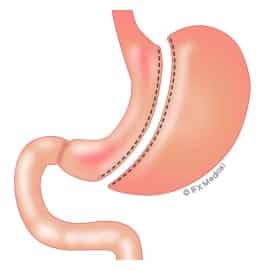Also known as vertical sleeve gastrectomy or gastric sleeve surgery, this procedure removes about 85 percent of the stomach’s outer curve, leaving a sleeve of stomach capable of holding between 50 and 150 mL that is about the size of a banana.
By making the stomach significantly smaller, gastric sleeve patients are able to lose weight by reducing the amount of food they can eat at one time. Reducing stomach size also decreases the number of hunger hormones produced in the stomach, which makes it easier to control eating habits. Sleeve gastrectomy leaves the stomach’s original connections to the esophagus and small intestine unchanged and is performed using minimally invasive laparoscopic procedures.

Advantages of Sleeve Gastrectomy
- Patients lose an average of 55 percent excess body weight.
- Helps resolve type 2 diabetes, obstructive sleep apnea, high blood pressure and hyperlipidemia.
- Digestive tract remains unchanged, allowing vitamins and nutrients to be fully absorbed.
- No post-surgical adjustments required.
- Reduces recovery time and risk of infection.
Potential Risks
As with any major surgery, sleeve gastrectomy can result in complications, including:
- Leaks in the sleeve
- Dyspepsia
- Ulcers
- Stricture, or narrowing of the sleeve
- Esophageal dysmotility, the development scar tissue in the esophageal lining
A sleeve gastrectomy removes a large portion of the stomach and therefore cannot be reversed. Before undergoing sleeve gastrectomy, you should discuss the potential surgical risks and complications with your bariatric surgeon, Dr. Taylor and consider other options like gastric bypass surgery and gastric band.
Suggested Reading
Medicare May Cover Sleeve Gastrectomy
Switch Things Up with Interval Training
Top 5 Gastric Sleeve FAQ
Also In This Section
- Switch Things Up with Interval Training
- Adjusting your Lap Band
- Tips for Working out after Lap Band Surgery
- Recipe Tips Following Gastric Bypass
- Gastric Bypass Improves Hopes of Conception
- The Benefits of Laparoscopic Adjustable Gastric Banding (Lap Band Surgery)
- Exercises for After Your Lap Band Surgery
- Top 5 Questions to Ask your Surgeon about Gastric Bypass Surgery
- Top 5 Gastric Sleeve FAQ
- Minimum Criteria for Lap-band Adjusted

